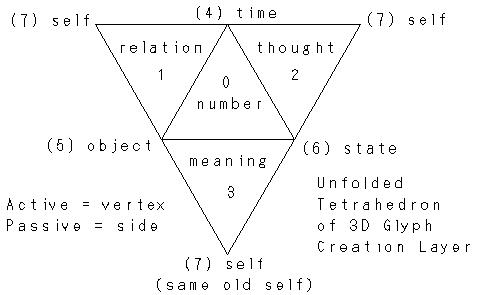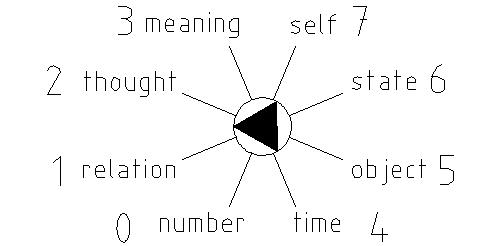
Alternate views of Creation layer
(The differences between)
The following is a speculative investigation into the
philosophical (or perhaps phylosophical) underpinnings of the
Instrumentation ontology. Understanding this material is not
necessary (or even possible, in some places, I suspect).
Each Instrumentation glyph Layer is actually composed of four
Disjunctive Complements. The passive types align along the "more
or less control" axis while the active types align along the "stable
or transitional" axis.
This illusory parallax results from the 'folding' of trigram context-space, from a non-orthogonal three-dimensional construct (a regular tetrahedron, where all 60 degree [omni-distributed] axis are isometric and each Type is equidistant from every other Type [within active or passive], except for its 'polar' opposite) into a polar two-dimensional glyph (to facilitate viewing, visualization and finger placement), as you can see in the diagrams below.


| Value |
Pair |
Axis |
Realm |
| 5 | Meaning and thought | both more control (this is the strongest pair) |
mental |
| 4 | Self and object | stable over transitional | existential |
| 2 | State and time | transitional over stable | consequential |
| 1 | Relation and number | both less control (this is the weakest pair) |
experiential |
The "active pairs" also appear to be "forced away from each other" in the glyph view, but this pseudo repulsion is really just an (optical) illusion caused by their non-euclidean two-dimensional 'shadows' from their non-rectilinear frame of reference (which would be the original '3D' tetrahedron within an "isometric vector matrix").
In general, the Disjunctive Complements have a profound influence on human ability to perceive the existence of their partners (in both directions), but the existence of human perception does not predicate a symmetric reflective relationship. A relationship between Thought and Meaning is only 'apparent' in light of human consciousness.
Time cannot be observed directly, but we infer its existence when we perceive successive changes in the States of things around us. Likewise, we would not be aware of the possibility of multiple States without Time passing. We require both to be present before we can discern the existence of either one. They, however, do not require us or each other in order to achieve validity or inhabit reality. This is tantamount to the difference between meaning and thought.
Prosaically, a tree falling in a forest will *always* make a sound. This is true even if no creature has ever evolved the ability to detect or interpret atmospheric pressure oscillations. This egocentric confusion as to the causality of coincidence and effect is the root of "Complementary Disjunction".
To complete this proof, I offer the following "thought experiment":
"Only a human would require an explanation of the above."
( Please achieve enlightenment now )